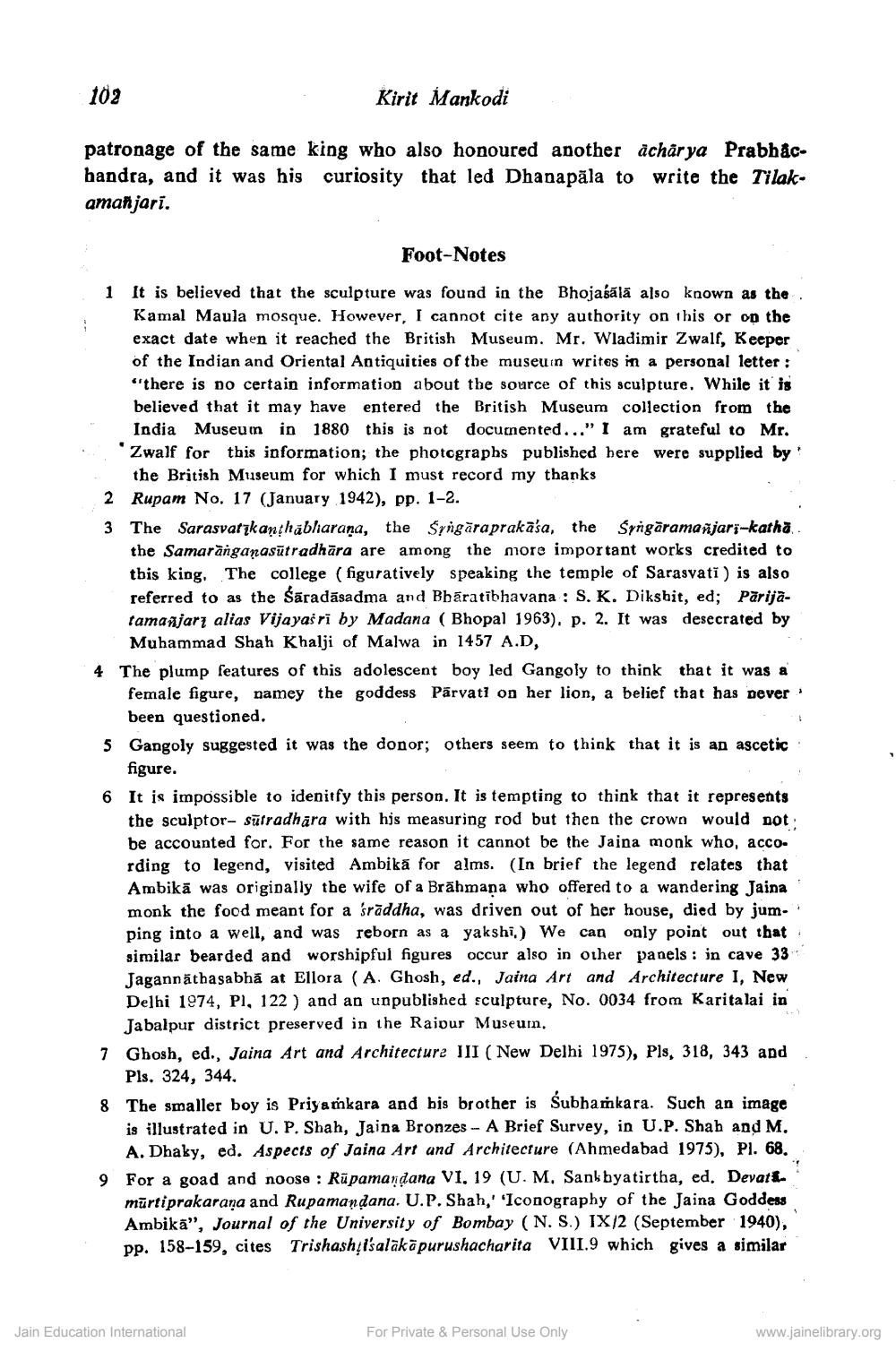________________
102
Kirit Mankodi
patronage of the same king who also honoured another acharya Prabhachandra, and it was his curiosity that led Dhanapăla to write the Tilakamaħjari.
Foot-Notes
1 It is believed that the sculpture was found in the Bhojaśālā also known as the
Kamal Maula mosque. However, I cannot cite any authority on this or on the exact date when it reached the British Museum. Mr. Wladimir Zwall, Keeper of the Indian and Oriental Antiquities of the museuin writes in a personal letter : "there is no certain information about the source of this sculpture. While it is believed that it may have entered the British Museum collection from the India Museum in 1880 this is not documented..." I am grateful to Mr. Zwalf for this information; the photographs published here were supplied by
the British Museum for which I must record my thanks 2 Rupam No. 17 (January 1942), pp. 1-2. 3 The Sarasvatikanthabharana, the Syngāraprakāša, the Syrigāramanjari-katha..
the Samarānganasūtradhāra are among the more important works credited to this king. The college (figuratively speaking the temple of Sarasvati ) is also referred to as the Śāradāsadma and Bhāratibhavana : S. K. Dikshit, ed; Pārijātamanjarz alias Vijayasri by Madana ( Bhopal 1963). p. 2. It was desecrated by
Muhammad Shah Khalji of Malwa in 1457 A.D, 4 The plump features of this adolescent boy led Gangoly to think that it was a
female figure, namey the goddess Pārvati on her lion, a belief that has never
been questioned. 5 Gangoly suggested it was the donor; others seem to think that it is an ascetic
figure. 6 It is impossible to idenitfy this person. It is tempting to think that it represents
the sculptor- süfradhara with his measuring rod but then the crown would not be accounted for. For the same reason it cannot be the Jaina monk who, acco. rding to legend, visited Ambika for alms. (In brief the legend relates that Ambikā was originally the wife of a Brāhmaṇa who offered to a wandering Jaina monk the food meant for a śrāddha, was driven out of her house, died by jumping into a well, and was reborn as a yakshi.) We can only point out that similar bearded and worshipful figures occur also in other panels : in cave 33 Jagannathasabhã at Ellora (A. Ghosh, ed., Jaina Art and Architecture I, New Delhi 1974, PI, 122) and an unpublished sculpture, No. 0034 from Karitalai in
Jabalpur district preserved in the Raipur Museumn. 7 Ghosh, ed., Jaina Art and Architecture III ( New Delhi 1975), Pls, 318, 343 and
Pls. 324, 344. 8 The smaller boy is Priyakara and bis brother is Subhamkara. Such an image
is illustrated in U. P. Shah, Jaina Bronzes - A Brief Survey, in U.P. Shah and M.
A. Dhaky, ed. Aspects of Jaina Art und Architecture (Ahmedabad 1975), Pl. 68., 9 For a goad and noose : Rūpamandana VI. 19 (U. M. Sankhyatirtha, ed. Devat
mürtiprakarana and Rupamandana. U.P. Shah,' 'Iconography of the Jaina Goddess Ambikā", Journal of the University of Bombay (N. S.) IX/2 (September 1940), pp. 158-159, cites Trishashi'salakāpurushacharita VIII.9 which gives a similar
Jain Education International
For Private & Personal Use Only
www.jainelibrary.org




